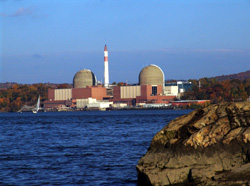On Sept. 29, 2013,
Indian Point 2 will enter what’s called the period of “
timely renewal,” while the NRC continues its consideration of Entergy’s application to renew the unit’s operating license.
 |
| Indian Point |
The NRC’s timely renewal regulation implements a provision of the Administrative Procedure Act passed by Congress. Under that regulation, if a licensee requests a renewed license at least five years before expiration of its current license, the request is considered “timely” and the facility is allowed to continue to operate under its existing license until the NRC completes its review and reaches a decision on the license renewal request.
During the period of timely renewal, Entergy will have to continue to meet all of the regulations and license conditions that currently apply. In addition, in a
May 1 letter to the NRC, Entergy voluntarily committed to update its Final Safety Analysis Report to include the aging management programs, and to implement the commitments it has made, for a renewed license. Indian Point 2 will continue to operate under its current license with these modifications, to assure continued safe operation during the timely renewal period, until the NRC reaches a decision on whether to approve the license renewal application.
Entergy submitted a license renewal application for Indian Point 2 and 3 in April 2007. The current operating license for Indian Point 2 expires at midnight September 28th; Unit 3’s license expires two years later, in December 2015.
Typically, the NRC staff takes about 18 to 24 months to review a reactor license renewal application. If there’s a hearing on the application, the process may take about 30 months to complete. In the Indian Point case, the hearing has taken longer than projected, in part due to the large number of contentions the parties have raised in the proceeding.
In addition, a decision on the Indian Point license renewal application has been deferred pending further Commission action involving the Waste Confidence Decision. In its Waste Confidence Decision and Temporary Storage Rule, updated in 2010, the Commission made a generic determination that spent nuclear fuel can be stored safely and without significant environmental impacts for a certain period of time after a nuclear plant permanently shuts down. In June of last year, the D.C. Circuit Court of Appeals found that some aspects of the 2010 Waste Confidence rule update did not satisfy the NRC’s obligations under the National Environmental Policy Act and vacated that rule. In response, the Commission decided to defer all final licensing decisions that rely on the Waste Confidence Decision while it takes steps to address the court’s decision. This applies to various license applications, including the Indian Point 2 license renewal application.
The NRC will continue to provide oversight of activities at both Indian Point 2 and 3 during the period of timely renewal. Last year, NRC conducted 11,000 hours of inspection at the two units. NRC will devote a similar number of inspection hours this year. Some of that includes inspection of the licensee’s commitments and aging management programs related to license renewal.
In short, even though a final decision hasn’t been reached on the renewal of the Indian Point 2 license, NRC will continue to assure that it operates safely during the period of timely renewal. (
NRC)

















